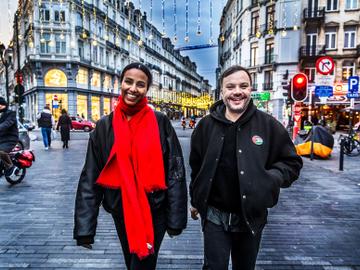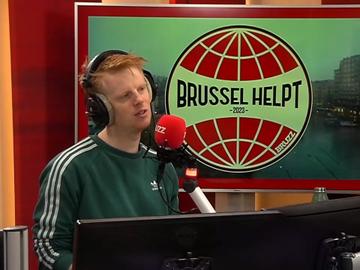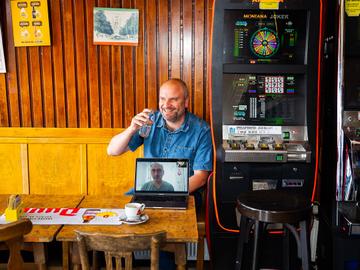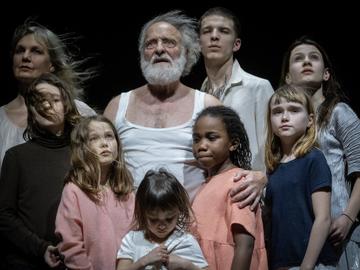“Turn and face the strange”: that which David Bowie sang about half a century ago, performance artist Kate McIntosh now wraps up in good advice. In To Speak Light Pours Out, she uses complex polyrhythms to explain that social change is only possible if we dare to connect with what we do not know.
© Christian Schuller
Kate McIntosh has never been afraid of breaking down barriers. Whether they were barriers between disciplines, between stage and audience or between cultures, the Brussels-New Zealand performance artist always sought cross-pollination, just as in To Speak Light Pours Out. Conceived in 2019 and created in the Covid year 2020, she has finally taken the show on tour. But when we Zoom with her, she has been in isolation in a Norwegian hotel room for four days. The timing with which Covid struck could have been better, but if everything goes to plan, she will soon belong to the quartet of performers who will indulge in drumming on stage, both in Trondheim and certainly in her (second) home in Brussels.
To Speak Light Pours Out mixes prophecies, manifestos and academic texts expressing positive ideas about social transformation with dance, song and complex polyrhythmics. “That drumming was a learning process, because our primary background is in dance. Physically, it fitted well. Above all, we had to learn to be better listeners.” This ties in with the message McIntosh wants to convey with her performance, that new ideas often come from places where they are not easily heard. “They come from voices and in ways we are not familiar with. So learning to listen to things we had never heard before was crucial.”
If we listen to music together in the same space, after a while our hearts will beat in sync, but our breathing will remain polyrhythmic. That is what it says in the announcement of To Speak Light Pours Out.
Kate McIntosh: Isn't that wonderful? It is based on scientific research that examined people who shared a certain space and more specifically studied how their bodies reacted to being together. Above all, I see the poetic layers in it. It says something about the harmonious feeling that comes with sharing and connecting. At the same time, it shows that there will always be differences that co-exist but also cause tension with what we have in common. These differences are often framed as problematic or something we should be afraid of, whereas they can also be very exciting and beautiful. When David Bowie sings “Turn and face the strange” in “Changes”, he also means that the strange is not necessarily outside yourself. Real change is about becoming unfamiliar with yourself.
Wherever people come together to experience a performance, they are as much concerned with each other as with the performance
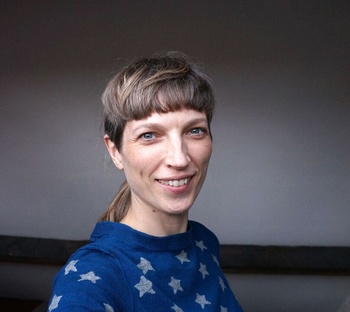
By interweaving lyrics with complex rhythms, you don't make it easy for the listener.
McIntosh: The ideas we wanted to communicate are also complex. But they deserve to be available in an accessible way, so we have removed all specialised terms from the text and that makes the presentation clear and transparent in terms of language. Because we are well aware that it is not easy for everyone to listen to different rhythms at the same time, we also explain at the beginning of the performance what polyrhythmics is and how rhythms can almost sit on top of each other as well as disrupt each other.
And the complex listening exercise ultimately becomes a metaphor for different views of society. Some visions simplify, others can retain complexity. At some point, we make a metaphorical bonfire in which we get rid of some old, violent world views. We are not fixated on the destination – we don't know what it is yet – but on getting there, because that we can influence. Listening to each other better can be a path and can give each other energy, too. One of the most beautiful lines in the Hopi Nation prophecy from the performance is “We have to push off from the shore into the middle of the river / See who is there with us and celebrate.” Being able to really see who is with you and celebrate that is essential, and exactly the opposite of what a war makes possible.
That same Hopi Nation prophecy says that before we can achieve a better future, we must first pass through the eye of the storm.
McIntosh: You are referring to the line: “They will try to hold on to the shore. They will feel they are being torn apart and will suffer greatly.” The image of being ripped apart is interesting because it also requires the ripping apart of a kind of self-understanding. It may be your privilege, or your oppression, or some other framework that society has made for you. It is painful, but it does not have to be an individual process.
Has the performance changed since war came back in Europe?
McIntosh: Certainly. We were playing in Berlin when the war broke out. Stopping the conditions that allow violence becomes more urgent when bombs are falling, but they have always been there, so we have to work harder on them even in peacetime. In the Hopi Nation prophecy, the river symbolises social change. During the performance, we celebrate the flow of the river. I like to contrast the “future flow” with the “backward throw” of a violent history. The main thing is that, precisely because war is manmade, we can also stop it.
How has adding text to your performances changed your own perspective and that of your audience?
McIntosh: In my early stage work, say up until 2015, text was essential, but then over the next five years my work was mostly immersive and interactive where the audience became the focus. These works had little language, if any, because they required a gentle, caring attitude towards my audience. Political positions were present, but were communicated implicitly. Now that there is no risk to the audience because they are not physically involved, I become extremely explicit and loud again, which I like, also because it ties in with my past with Poni (a punk rock collective, ed.). I have a feeling that a lot of young people are energised by it.
In my first pieces, I drew on the perspective of stand-up comedians, who rely on the immediate reaction of their audience. For me, a performance is fundamentally a public gathering. The place where people connect, if only by their heartbeat, has always been central to my work. I am convinced that wherever people come together to experience a performance, they are as much concerned with each other as with the performance. I try to honour and facilitate that. Audiences are very curious about each other and therefore listen to each other like crazy. That's the first thing you learn when you do comedy. That every breath, movement and cough indicates that an audience is doing it for each other. Superbly fascinating subject matter. I should really become a sociologist. (Laughs)
You once said that you love Brussels because the city is not pure.
McIntosh: For an artist, having the opportunity to enjoy different languages and realities that intertwine with each other is invaluable. Call it the polyrhythm of the city. There is complexity present in New Zealand too, but there it is mainly due to the contrast between the centre and the periphery. That, of course, is a very centrist European and colonial viewpoint. But again, change always comes from elsewhere, from voices we do not yet know how to listen to.
Read more about: Podium , Kate McIntosh , Kaaitheater
